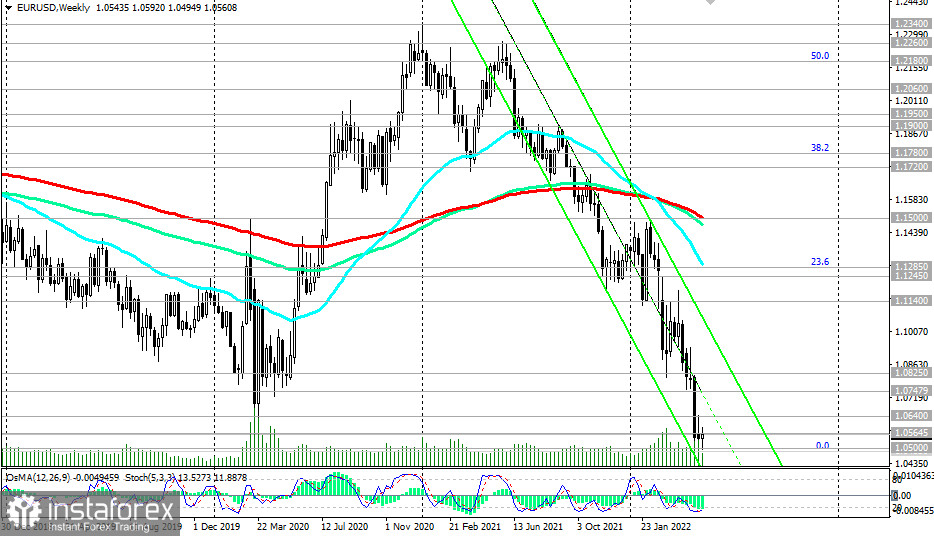During its meeting in April, the European Central Bank, as expected, kept its policy unchanged, leaving rates at the same levels: the key rate at 0.00%, the deposit rate at -0.50%, the marginal rate at a mark of 0.25%.
The ECB said in a statement that incoming economic data had increased the likelihood that the central bank would complete its bond purchases in the third quarter. The bank noted that purchases will be curtailed gradually: from 40 billion euros in April to 30 billion euros in May and 20 billion euros in June.
As ECB President Christine Lagarde said during a press conference, "inflation has increased significantly and will remain high over the coming months, mainly because of the sharp rise in energy costs," although the situation with core inflation is not yet clear.
And today, Christine Lagarde confirmed that the Asset Purchase Program (APP) should be completed at the beginning of the third quarter. "Our inflation projections are increasingly pointing towards inflation being on target over the medium term. It is increasingly unlikely that the disinflationary dynamics of the past decade will return."
Her statements were confirmed by statements by other representatives of the ECB leadership. For example, European Central Bank Vice President Louis de Guindos said today that "inflation is likely to remain at the 4%-5% range at the end of the year in the eurozone" and "the debt-buying program, the asset purchase program, is likely to stop in July."
The euro fell sharply after the ECB meeting ended on April 14, and the EUR/USD pair reached a local 5-year low near 1.0470 at the end of last month.

Since the beginning of May, EUR/USD attempted to grow from the lows reached. So far, however, it has been doing poorly. The pair continues to trade near its lows, albeit above the 1.0500 support level.
The next meeting of the ECB will take place on June 9. Until the ECB takes concrete steps towards tightening its policy, the euro will remain under strong pressure, and the EUR/USD pair is under the threat of a new fall below 1.0500, towards euro parity with the dollar, economists say.
Some verbal interventions on the part of the ECB leaders are still not enough for a more or less stable strengthening of the euro and the growth of EUR/USD.
Moreover, the discrepancy between the dynamics of the rates of the Fed and the ECB, aimed at tightening their monetary policies, is accelerating.
At the same time, the European economy is facing risks of recession, including due to the ongoing military conflict in Ukraine, while the EU introduces new tough restrictive measures against the Russian economy. First of all, this concerns Russian energy carriers, on which the European economy depends very much, and some European countries are 100% dependent.
Although ECB leaders plan to end the APP in July, the bank will be able to start changing monetary policy parameters only some time later, after the complete cessation of securities buybacks, and this increase will be gradual. In general, the position of the ECB remains cautious and lags behind the position of the Fed in aggressiveness in curbing rising inflation.
Thus, with the advent of new drivers, we should expect a further decline in EUR/USD. A breakdown of the support levels at 1.0500, 1.0470 will confirm our assumption.
Today, data on consumer inflation in the US is expected for released at 12:30 GMT. The Consumer Price Index (CPI) is a key indicator for assessing inflation and changing consumer preferences. In March 2022, the value of the indicator (Core CPI) was +0.3% (+6.5% in annual terms), which indicates a strong increase in consumer inflation after the index fell in March and April 2020 against the backdrop of the coronavirus pandemic. Forecast for April: +0.4% and +6.0% (in annual terms).
If the data turns out to be weaker than the forecast, then the dollar is likely to react with a decline, but only a short-term one. Economists believe that there are no serious prerequisites for reducing real inflation now: energy and food prices, as we noted above, are rising, coupled with the actions of the Fed, introducing uncertainty into the market and forcing its participants to get rid of risky assets in favor of a protective dollar.
 English
English 
 Русский
Русский Bahasa Indonesia
Bahasa Indonesia Bahasa Malay
Bahasa Malay ไทย
ไทย Español
Español Deutsch
Deutsch Български
Български Français
Français Tiếng Việt
Tiếng Việt 中文
中文 বাংলা
বাংলা हिन्दी
हिन्दी Čeština
Čeština Українська
Українська Română
Română

